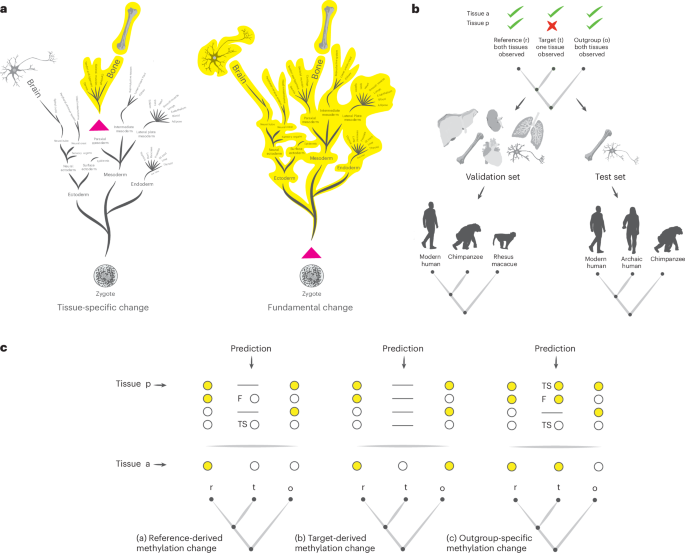推断古代标本非骨骼组织中的 DNA 甲基化
IF 13.9
1区 生物学
Q1 ECOLOGY
引用次数: 0
摘要
全基因组的死前DNA甲基化模式可以从古代样本的高覆盖率DNA序列中计算重建。由于 DNA 甲基化在不同物种间比不同组织间更为保守,而古代 DNA 通常是从骨骼和牙齿中提取的,因此之前利用古代 DNA 甲基化图谱的研究主要集中在研究骨骼系统的进化变化上。在这里,我们提出,在某些条件下,一个组织的 DNA 甲基化模式可能对同一个体其他组织的 DNA 甲基化模式有参考价值。利用组织特异性 DNA 甲基化在胚胎发育过程中形成的事实,我们确定了进行这种跨组织推断的条件,并设计了一种算法来进行推断。我们在现存物种的甲基化数据上对算法进行了训练,验证数据集的精确度高达 0.92。然后,我们在古人类身上使用了该算法,并确定了 1850 多个位置,在这些位置上,我们可以观察到前额叶皮层神经元的 DNA 甲基化差异。这些位置与数百个基因相关联,其中许多涉及神经功能,如结构和发育过程。其中六个位置位于神经母细胞瘤断裂点家族(NBPF)基因家族,该家族可能在人类大脑进化过程中扮演了重要角色。我们在这里介绍的算法可以研究古生物记录中没有的组织和细胞类型的表观遗传变化,因此为研究表观遗传变化对进化的影响提供了新的方法。本文章由计算机程序翻译,如有差异,请以英文原文为准。


Inferring DNA methylation in non-skeletal tissues of ancient specimens
Genome-wide premortem DNA methylation patterns can be computationally reconstructed from high-coverage DNA sequences of ancient samples. Because DNA methylation is more conserved across species than across tissues, and ancient DNA is typically extracted from bones and teeth, previous works utilizing ancient DNA methylation maps focused on studying evolutionary changes in the skeletal system. Here we suggest that DNA methylation patterns in one tissue may, under certain conditions, be informative on DNA methylation patterns in other tissues of the same individual. Using the fact that tissue-specific DNA methylation builds up during embryonic development, we identified the conditions that allow for such cross-tissue inference and devised an algorithm that carries it out. We trained the algorithm on methylation data from extant species and reached high precisions of up to 0.92 for validation datasets. We then used the algorithm on archaic humans, and identified more than 1,850 positions for which we were able to observe differential DNA methylation in prefrontal cortex neurons. These positions are linked to hundreds of genes, many of which are involved in neural functions such as structural and developmental processes. Six positions are located in the neuroblastoma breaking point family (NBPF) gene family, which probably played a role in human brain evolution. The algorithm we present here allows for the examination of epigenetic changes in tissues and cell types that are absent from the palaeontological record, and therefore provides new ways to study the evolutionary impacts of epigenetic changes. The authors show that DNA methylation patterns in one tissue can inform on those in another, under certain conditions, and devise an algorithm that allows identification of differential DNA methylation. They applied it to an archaic human dataset, revealing information about human brain evolution in the absence of preserved brain tissue.
求助全文
通过发布文献求助,成功后即可免费获取论文全文。
去求助
来源期刊

Nature ecology & evolution
Agricultural and Biological Sciences-Ecology, Evolution, Behavior and Systematics
CiteScore
22.20
自引率
2.40%
发文量
282
期刊介绍:
Nature Ecology & Evolution is interested in the full spectrum of ecological and evolutionary biology, encompassing approaches at the molecular, organismal, population, community and ecosystem levels, as well as relevant parts of the social sciences. Nature Ecology & Evolution provides a place where all researchers and policymakers interested in all aspects of life's diversity can come together to learn about the most accomplished and significant advances in the field and to discuss topical issues. An online-only monthly journal, our broad scope ensures that the research published reaches the widest possible audience of scientists.
 求助内容:
求助内容: 应助结果提醒方式:
应助结果提醒方式:


